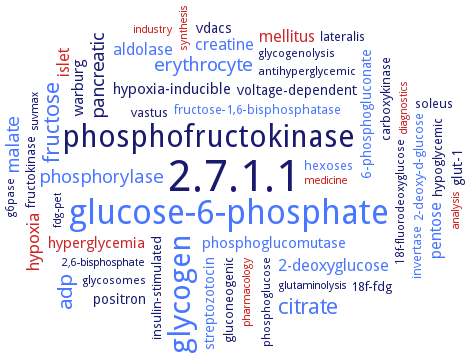2.7.1.1: hexokinase
This is an abbreviated version!
For detailed information about hexokinase, go to the full flat file.

Word Map on EC 2.7.1.1 
-
2.7.1.1
-
glucose-6-phosphate
-
phosphofructokinase
-
glycogen
-
fructose
-
citrate
-
adp
-
erythrocyte
-
malate
-
phosphorylase
-
pancreatic
-
hypoxia
-
islet
-
pentose
-
creatine
-
mellitus
-
2-deoxyglucose
-
aldolase
-
hyperglycemia
-
phosphoglucomutase
-
warburg
-
hypoxia-inducible
-
6-phosphogluconate
-
glut-1
-
voltage-dependent
-
vdacs
-
streptozotocin
-
positron
-
soleus
-
18f-fdg
-
lateralis
-
fructose-1,6-bisphosphatase
-
hypoglycemic
-
invertase
-
2-deoxy-d-glucose
-
fructokinase
-
gluconeogenic
-
insulin-stimulated
-
carboxykinase
-
hexoses
-
vastus
-
glycogenolysis
-
g6pase
-
glycosomes
-
antihyperglycemic
-
phosphoglucose
-
18f-fluorodeoxyglucose
-
fdg-pet
-
pharmacology
-
suvmax
-
analysis
-
glutaminolysis
-
2,6-bisphosphate
-
synthesis
-
diagnostics
-
industry
-
medicine
- 2.7.1.1
- glucose-6-phosphate
-
phosphofructokinase
- glycogen
- fructose
- citrate
- adp
- erythrocyte
- malate
- phosphorylase
- pancreatic
- hypoxia
- islet
- pentose
- creatine
- mellitus
- 2-deoxyglucose
- aldolase
- hyperglycemia
- phosphoglucomutase
-
warburg
-
hypoxia-inducible
- 6-phosphogluconate
-
glut-1
-
voltage-dependent
-
vdacs
- streptozotocin
-
positron
- soleus
-
18f-fdg
- lateralis
- fructose-1,6-bisphosphatase
-
hypoglycemic
- invertase
- 2-deoxy-d-glucose
- fructokinase
-
gluconeogenic
-
insulin-stimulated
-
carboxykinase
- hexoses
-
vastus
-
glycogenolysis
- g6pase
- glycosomes
-
antihyperglycemic
-
phosphoglucose
-
18f-fluorodeoxyglucose
-
fdg-pet
- pharmacology
-
suvmax
- analysis
-
glutaminolysis
-
2,6-bisphosphate
- synthesis
- diagnostics
- industry
- medicine
Reaction
Synonyms
6-phosphate glucose kinase, AtHXK1, ATP-D-hexose 6-phosphotransferase, ATP-D-hexose-6-phosphotransferase, ATP-dependent hexokinase, ATP: D-glucose 6-phosphotransferase, ATP: D-hexose 6-phosphotransferase, ATP:D-glucose 6-phosphotransferase, ATP:D-hexose 6-phosphotransferase, BmHk, brain form hexokinase, CzHXK1, FgHXK1, FgHXK2, GCK, GK, GKbeta, GlcK, glk, GlkB, glucokinase, glucokinase 1, glucokinase B, glucose ATP phosphotransferase, HaHXK1, hexokinase, hexokinase (phosphorylating), hexokinase 1, hexokinase 2, hexokinase 3, hexokinase 6, hexokinase A, hexokinase D, hexokinase Dor, hexokinase I, hexokinase II, hexokinase III, hexokinase IV, hexokinase PI, hexokinase PII, hexokinase type I, hexokinase type II, hexokinase type IV, hexokinase type IV glucokinase, hexokinase, tumor isozyme, hexokinase-1, hexokinase-10, hexokinase-2, hexokinase-4, hexokinase-5, hexokinase-6, hexokinase-7, hexokinase-8, hexokinase-9, hexokinase-II, hexokinase-like 1, hGK, hGK isoform 1, HK, HK II, HK-1, HK-I, HK-R, HK1, HK2, HK4, HKDC1, HKI, HKII, HKIII, HKL1, HPGLK1, HXK, HXK A, HXK II, Hxk1, HXK10, Hxk2, Hxk3, HXK4, HXK5, HXK6, HXK7, HXK8, HXK9, hxkC, hxkD, kinase, hexo- (phosphorylating), KlHxk1, LGK, LGK2, liver glucokinase, liver glucokinase isoform 2, MODY2 glucokinase, More, muscle form hexokinase, NfGlck, NtHXK1, OsHXK, OsHXK1, OsHXK10, OsHXK2, OsHXK3, OsHXK4, OsHXK5, OsHXK6, OsHXK7, OsHXK9, pHXK, plastid hexokinase, PpHXK1, PpHXK10, PpHXK11, PpHXK2, PpHXK3, PpHXK4, PpHXK5, PpHXK6, PpHXK7, PpHXK8, PpHXK9, Rag5p, ROK hexokinase, ScHK2, ScHXK2, SoHXK1, StHK, STK_23540, StoHK, TbHK1, TbHK2, TcHK, TthHK, type II hexokinase, VIT_18s0001g14230, xprF, Zm.5206, Zm.95484


 results (
results ( results (
results ( top
top





